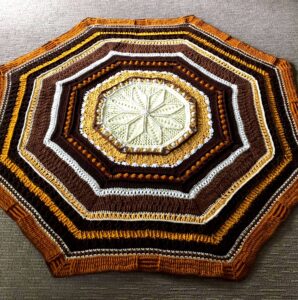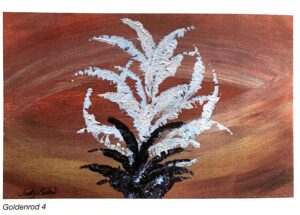This is the fourth part of a five-part blog series with this outline
Part One: Personal Background Information (Release Date: 3-16-22)
Part Two: Information Storage – Bridge Pieces (Release Date: 3-30-22)
Part Three: Information Processing – The Gaps (Release Date: 4-13-22)
Part Four: Information Retrieval – Canoe Transportation (Release Date: 4-27-22)
Part Five: Conclusion (Release Date: 5-11-22)
Hard stone islands of information solidified
with little bridge pieces jutting off their sides
suspended inside
the gray-matter space
of her mind.
Islands of information each unto themselves
not able to share their information
one island with another
because the little bridge pieces
jutting off their sides
never did grow to form any bridges
as they were originally meant to.
When she needed info from more than one island
it became very difficult to gather
with no bridges to span the gaps
in that gray-matter space
between her bazillion
inside-her-mind stone islands.
Slowly, over time she constructed a boat
so that she might float about
in that gray-matter space of her mind
to gather up info,
stone island by island.
The boat took ever so long to construct
because there were no raw materials,
nothing to use to build a boat with
in that inside-her-mind space filled up with stone islands.
She started to watch outside of her skin
to see what she could find to build a stone island boat with.
It was tricky because she couldn’t use any boards or nails
that were outside of skin in the world
to drag into that gray-matter space
of her inside-her-mind world of stone islands.
And yet, she needed materials she could use to build a boat
that she could then climb inside of and float in
from island to island
gathering bits and pieces of world-info needed
when she needed to assimilate all of the relevant data
pertinent to some current, given, relative now,
in-front-of-her-face everyday commonplace
world conversation.
Over time she discovered that if she could live in
an outside her skin world of specific order, not left to chance,
it gave her a chance
to be able to travel
between her stone islands.
What worked best was to stick to a schedule –
the same schedule ever day –
so she always would know ahead of time
just exactly what to expect.
And the more she could keep things the same
in the world outside of her skin,
the better the chance that her boat would float
rather than sinking down
in the gray-matter space
of the inside-her-mind place
of that stone island world inside her.
Her boat began to look like a canoe with two sides
and a seat in the middle.
One side of her canoe
was her daily schedule
that she tried to keep the same each day
as much as she was humanly able.
The other side of her canoe was constructed
as a result her scavenger hunting
in places outside of her skin
where world-people walk and talk
and seem comfortable living in.
She made a habit of listening in on the world-people space
that was all over the place
just over the line on the other side
of the outside side of her skin.
She became a scavenger on the lookout for bits and clues
that might show her just what to expect
ahead of time – before it would actually happen –
in that world-people world right outside her.
The more bits and clues that she could pick up and use,
the stronger that side of her boat became
until it matched in the strength with the other side
that was built with her daily schedule.
Then she found that for her to sit down in this boat of two sides
she needed a seat upon which to sit
because if she stood up the boat would flip
dumping her out into the gaps of gray-matter space
making her flail about desperately
going nowhere except sinking down
drowning inside of herself.
One day she discovered quite by accident that in her boat she sat
On a seat that had constructed itself out of her matching habits.
It very much surprised her
when she looked at the boat
and saw her morning activities
spread between boat sides,
building the boat seat in the middle
right before her very own eyes!
She had:
matched the socks in her sock drawer
and folded all her pants the same.
Her clean sheets and pillowcase were a set,
and the colors of her clothes matched each other.
In the cafeteria she noticed all the plates were the same
and the silverware matched together.
All the cups were green.
All the trays were brown
and all the kids sat down
at exactly
the same kind
of little square tables.
After studying the boat seat she was able to discover
just how it had been made.
When everything matched and looked the same
in the outside-her-skin world-people world
she could sit back and relax
in a comfortable way
on the inside side of her skin.
Sitting like this in her boat she could float
in gray-matter space between islands,
finding islands containing that info she needed
right in each moment of time…
her previously stored, cast in stone,
forever preserved, encapsulated
world-people information
of what-to-do-when
and
how-to-act-if
and
when-to-say-what,
Because of this two-sided boat
with its seat in the middle
stone island info
was now retrievable.
Selection from Autistically Thriving: Reading Comprehension, Conversational Engagement, and Living a Self-Determined Life Based on Autistic Neurology, pgs. 109-112.
The first photo shows an afghan I crocheted to match an acrylic I painted some years earlier.
`
`
`
Note: The author is a mental health therapist and is also autistic. She intentionally uses identity-first language (rather than person-first language), and invites the reader, if interested, to do further research on the preference of most autistic adults to refer to themselves using identity-first language.
BOOKS BY JUDY ENDOW
Endow, J. (2021). Executive Function Assessment. McFarland, WI: Judy Endow.
Endow, J. (2019). Autistically Thriving: Reading Comprehension, Conversational Engagement, and Living a Self-Determined Life Based on Autistic Neurology. Lancaster, PA: Judy Endow.
Endow, J. (2012). Learning the Hidden Curriculum: The Odyssey of One Autistic Adult. Shawnee Mission, KS: AAPC Publishing.
Endow, J. (2006). Making Lemonade: Hints for Autism’s Helpers. Cambridge, WI: CBR Press.
Endow, J. (2013). Painted Words: Aspects of Autism Translated. Cambridge, WI: CBR Press.
Endow, J. (2009b). Paper Words: Discovering and Living With My Autism. Shawnee Mission, KS: AAPC Publishing.
Endow, J. (2009a). Outsmarting Explosive Behavior: A Visual System of Support and Intervention for Individuals With Autism Spectrum Disorders. Shawnee Mission, KS: AAPC Publishing.
Endow, J. (2010). Practical Solutions for Stabilizing Students With Classic Autism to Be Ready to Learn: Getting to Go. Shawnee Mission, KS: AAPC Publishing.
Myles, B. S., Endow, J., & Mayfield, M. (2013). The Hidden Curriculum of Getting and Keeping a Job: Navigating the Social Landscape of Employment. Shawnee Mission, KS: AAPC Publishing.

